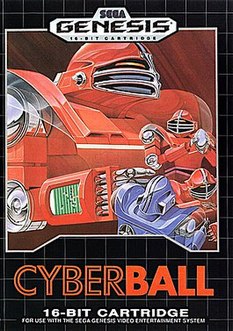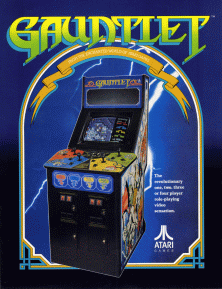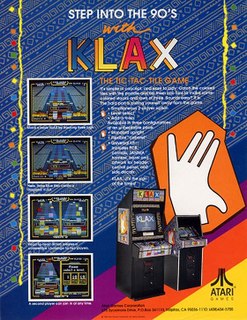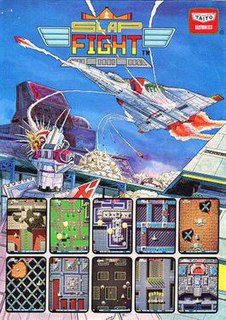 W
WAfter Burner is an arcade vehicular combat game developed and released by Sega in 1987. The player assumes control of an American F-14 Tomcat fighter jet, and must clear each of the game's eighteen unique stages by destroying incoming enemies, using both a machine gun and a limited supply of heat-seeking missiles. It uses a third-person perspective, previously utilized by Sega's earlier games Space Harrier (1985) and Out Run (1986), and runs on the Sega X Board arcade system, which is capable of surface and sprite rotation. It is the fourth Sega game to use a hydraulic "taikan" motion simulator arcade cabinet, one that is more elaborate than their earlier "taikan" simulator games. The cabinet simulates an aircraft cockpit, with flight stick controls, a chair with seatbelt, and hydraulic motion technology that moves, tilts, rolls and rotates the cockpit in sync with the on-screen action.
 W
WAlien Syndrome is a run and gun game developed by Sega and released in arcades in 1987.
 W
WAwesome Possum... Kicks Dr. Machino's Butt is a video game created by Tengen for the Sega Mega Drive/Genesis that was released in late 1993. It also had many lines of digitized speech, unusual for its time, a feature with which the game was marketed. The box also states "it is an excellent educational game for all ages". The game included the voice talents of Walter Fields, Laurie Amat and Douglas Lawrence.
 W
WCyberball is a video game released in arcades in 1988 by Atari Games. The game is 7-man American football using robotic avatars of different speeds, sizes, and skill sets set in the year 2022. Originally released to arcades, Cyberball was ported to several home consoles.
 W
WDevil's Crush is a pinball video game developed by Compile for the TurboGrafx-16 and released in 1990. The second installment in the Crush Pinball series after Alien Crush, the game has an eerie occult theme with skulls, skeletons, and demons. It was later followed by Jaki Crush and Alien Crush Returns.
 W
WDragon's Revenge (ドラゴンズ・リベンジ) is a pinball video game by Tengen, released for Sega Genesis in 1993. It is a follow-up to Devil's Crush, a pinball game set in sword and sorcery scenario, wherein the player has to defeat a dragon and a witch. The game was released to generally positive reviews.
 W
WF1 is a 1993 racing video game published by Domark, based on Vroom, a game developed in 1991 for the Atari ST by French company Lankhor. It was released for the Mega Drive/Genesis, Master System, Game Gear, and Amiga. It spawned a sequel in 1994 titled F1 World Championship Edition, and the game engine was reused in Kawasaki Superbike Challenge. It was one of the most popular racing games in the console, mostly thanks to the smooth and fast game engine.
 W
WFantasy Zone is a 1986 arcade game by Sega, and the first game in the Fantasy Zone series. It was later ported to a wide variety of consoles, including the Master System. The player controls a sentient spaceship named Opa-Opa who fights an enemy invasion in the titular group of planets. The game contains a number of features atypical of the traditional scrolling shooter. The main character, Opa-Opa, is sometimes referred to as Sega's first mascot character.
 W
WGauntlet is a 1985 fantasy-themed hack-and-slash arcade game developed and released by Atari Games. It is noted as being one of the first multiplayer dungeon crawl arcade games. The core design of Gauntlet comes from 1983 Atari 8-bit dungeon crawl game Dandy, which resulted in a threat of legal action. It also bears striking similarities to the action-adventure maze game Time Bandit (1983).
 W
WGrind Stormer is a 1993 vertically scrolling shooter arcade video game originally developed and published by Toaplan in Japan and North America. It is considered to be the spiritual successor to Slap Fight. Based around a video game within a video game concept, players assume the role of a young secret agent assigned by the government taking control of the NA-00 space fighter craft in an attempt to defeat the titular virtual reality simulator, rescue the abducted players who lost against it and unveil its true purpose.
 W
WHard Drivin' is a 1989 driving video game developed by Atari Games. It invites players to test drive a sports car on courses that emphasize stunts and speed. The game features one of the first 3D polygon driving environments via a simulator cabinet with a force feedback steering wheel and using a custom rendering architecture. According to the in-game credit screen, Hard Drivin' was designed by two teams working concurrently in the United States and Ireland.
 W
WHydra is an arcade video game.
 W
WKlax is a puzzle video game released in arcades in 1990 by Atari Games while Namco distributed the game in Japanese markets. It was designed by Dave Akers and Mark Stephen Pierce. The object is to catch colored blocks tumbling down a machine and arrange them in colored rows and patterns to make them disappear. Klax was originally published as a coin-op follow-up to Tetris, about which Atari Games was in a legal dispute at the time.
 W
WMs. Pac-Man is a 1982 maze arcade game developed by General Computer Corporation and published by Midway. It is the first sequel to Pac-Man (1980) and the first entry in the series to not be made by Namco. Controlling the titular character, the player is tasked with eating all of the pellets in an enclosed maze while avoiding four colored ghosts. Eating the larger “power pellets” lets the player eat the ghosts, who turn blue and flee.
 W
WPac-Man is a 1980 maze action video game developed and released by Namco for arcades. The original Japanese title of Puck Man was changed to Pac-Man for international releases as a preventative measure against defacement of the arcade machines by changing the P to an F. In North America, the game was released by Midway Manufacturing as part of its licensing agreement with Namco America. The player controls Pac-Man, who must eat all the dots inside an enclosed maze while avoiding four colored ghosts. Eating large flashing dots called "Power Pellets" causes the ghosts to turn blue, allowing Pac-Man to eat them for bonus points.
 W
WPac-Mania is an isometric maze game that was developed and released by Namco for arcades in 1987. In the game, the player controls Pac-Man as he must eat all of the dots while avoiding the colored ghosts that chase him in the maze. Eating large flashing "Power Pellets" will allow Pac-Man to eat the ghosts for bonus points, which lasts for a short period of time. A new feature to this game allows Pac-Man to jump over the ghosts to evade capture. It is the ninth title in the Pac-Man video game series and was the last one developed for arcades up until the release of Pac-Man Arrangement in 1996. Development was directed by Pac-Man creator Toru Iwatani. It was licensed to Atari Games for release in North America.
 W
WPGA Tour Golf is a golf video game and the first in the PGA Tour game series. It was developed by Sterling Silver Software and released in 1990, for MS-DOS. It was initially published by Electronic Arts, which subsequently released versions of the game for Sega Genesis and Amiga in 1991, followed by a version for the SNES in 1992. By 1994, Tengen had published versions for Sega's Master System and Game Gear consoles. PGA Tour Golf received generally positive reviews for its realism, sound, and camera. Several critics considered the computer versions to be the best golf game available at the time of its release. It was followed by PGA Tour Golf II.
 W
WPit-Fighter is a 1990 arcade fighting game by Atari Games which uses digitized live actors. It was Atari's first fighting game. The Japanese arcade release was published by Konami. Home versions were published by Tengen.
 W
WR.B.I. Baseball is a baseball sports video game series. R.B.I. is an initialism for "run batted in". Originally launched in 1987 as a localized version of Namco's Family Stadium series, the R.B.I. Baseball series initially ran through 1995. In 2014, the series was rebooted as a competitor to MLB: The Show, with releases each year since.
 W
WR.B.I. Baseball 2 is the second game in the R.B.I. Baseball series.
 W
WRace Drivin' is a driving arcade game that invites players to test drive several high-powered sports cars on stunt and speed courses. The game is the sequel to 1989's Hard Drivin' and was part of a new generation of games that featured 3D polygon environments. Unlike most racing games of its time, it attempted to model real world car physics in the simulation of the movement of the player's car. Like Hard Drivin', the game is unique among video games in that it includes a true force feedback steering wheel, an ignition key, a four-speed shifter, and three foot pedals: an accelerator, a brake, and a clutch. Released in August 1990, approximately 1200 units were produced at the time of its release for roughly $9000 each.
 W
WRampart is a 1990 video game released by Atari Games and Midway Games that combines the shoot 'em up, strategy, and puzzle genres. It debuted as an arcade game with trackball controls, and was ported to home systems. It had a limited US release in October 1990, and a wide release in early 1991. It was distributed in Japan by Namco.
 W
WRoad Runner is a racing game based on the Wile E. Coyote and Road Runner shorts. It was released by Atari Games in 1985.
 W
WRolling Thunder is a run-and-gun shooter action game produced by Namco, originally released as a coin-operated arcade game which ran on the Namco System 86 hardware in 1986. It was distributed in North America by Atari Games. The player takes control of a secret agent who must rescue his female partner from a terrorist organization. Rolling Thunder was a commercial success in arcades, and was released for various home computer platforms in 1987 and the Nintendo Entertainment System in 1989. The original arcade game has also been included in various classic game compilations as well. It influenced later arcade action franchises such as Shinobi and Time Crisis, which borrowed mechanics such as taking cover behind crates.
 W
WShinobi (忍) is a side-scrolling hack-and-slash action game produced by Sega, originally released for arcades on the Sega System 16 board in 1987. The player controls ninja Joe Musashi, to stop the Zeed terrorist organization from kidnapping students of his clan.
 W
WSkull & Crossbones is a two-player video game developed by Atari Games and released in arcades in 1989.
 W
WSlap Fight is a 1986 vertically scrolling shooter arcade video game originally developed by Toaplan and published by Taito. Set on the colonized fictional planet of Theron in the future, where an alien race led by Gaudy have invaded the human-controlled location, players assume the role of an Allied League of Cosmic Nations (ALCON) fighter pilot taking control of the SW475 space fighter craft in a effort to counterattack the invaders. Initially launched for the arcades, the game was later ported to other microcomputer and console platforms by various third-party developers, with each one featuring several changes or additions compared to the original release.
 W
WSteel Talons is a 3D combat flight simulator arcade game released by Atari Games in 1991. The player takes on the role of a pilot for an "AT1196 Steel Talons combat helicopter". Steel Talons was ported to the Sega Genesis, Atari Lynx, Atari ST, and the Super Nintendo Entertainment System. A Jaguar port was announced, but never released.
 W
WSuper Sprint is a racing video game released by Atari Games and Midway Games in 1986. Up to three players drive Formula One-like cars on a circuit that is viewed from above. The game is a successor to Gran Trak 10 and the Sprint series, which were black-and-white games from the 1970s. A sequel, Championship Sprint, was released later in the same year.
 W
WTetris is a puzzle game developed by Atari Games and originally released for arcades in 1988. Based on Alexey Pajitnov's Tetris, Atari Games' version features the same gameplay as the computer editions of the game, as players must stack differently shaped falling blocks to form and eliminate horizontal lines from the playing field. The game features several difficulty levels and two-player simultaneous play.
 W
WToobin' is an Atari Games and Midway Games video game originally released as an arcade game in 1988 and is based on the recreational sport tubing. It was later ported to systems such as NES, Amiga, Commodore 64, MSX, and Game Boy Color. In the game, the player assumes control of the main characters Bif or Jet, guiding them through many winding rivers on an innertube.
 W
WVindicators is a one or two player arcade game released by Atari Games in 1988. Home ports were by Tengen. Vindicators was not licensed by Nintendo and used an alternate chip to defeat the 10NES lockout system. Ports were planned for the Atari Lynx and Apple IIGS, with the latter even completed, but both were cancelled. The arcade original was released for Windows PCs on Midway Arcade Treasures (2004).
 W
WXybots is a 1987 third-person shooter arcade game by Atari Games. In Xybots, up to two players control "Major Rock Hardy" and "Captain Ace Gunn", who must travel through a 3D maze and fight against a series of robots known as the Xybots whose mission is to destroy all mankind. The game features a split screen display showing the gameplay on the bottom half of the screen and information on player status and the current level on the top half. Designed by Ed Logg, it was originally conceived as a sequel to his previous title, Gauntlet. The game was well received, with reviewers lauding the game's various features, particularly the cooperative multiplayer aspect. Despite this, it was met with limited financial success, which has been attributed to its unique control scheme that involves rotating the joystick to turn the player character.